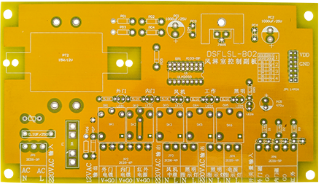1. After the customer's original data processing of the PCB is completed, it is determined that there is no problem and the process capability is met, and the first stop is entered, according to the work order issued by the engineer to determine the size of the PCB substrate, the material of the PCB, and the number of layers ……When the material is sent out, in simple terms, it is to prepare the materials needed to make the PCB.
2. Dry film of inner layer board. Dry film: It is a resist for photosensitivity, imaging, anti-plating and anti-etching. The photoresist is attached to the clean board surface by hot pressing. The water-soluble dry film is mainly due to its composition containing organic acid radicals, which will react with strong bases to become organic acid salts, which can be dissolved in water. It forms a water-soluble dry film, which is developed with sodium carbonate and stripped with dilute sodium hydroxide. The imaging action completed by the film. The PCB surface that is about to be processed in this step is "sticked" with a water-soluble dry film that will undergo a photochemical reaction, which can be exposed to light to show the prototype of all circuits on the PCB;
3. Exposure: The copper plate after pressing the film, and the PCB produced by the negative film are automatically positioned by the computer and then exposed, so that the dry film on the plate surface is hardened due to the photochemical reaction, so as to facilitate the subsequent copper etching. Exposure intensity and exposure time;
4. Development of the inner layer board: remove the unreceived dry film with a developer solution to leave the exposed dry film pattern;
5. Acid etching: etching the exposed copper to obtain the PCB circuit;
6. Remove the dry film: In this step, the hardened dry film attached to the surface of the copper plate is washed with a chemical solution, and the entire PCB circuit layer has been roughly formed by now;
7. AOI: Use automatic optical alignment inspection machine to check the correct PCB data to detect whether there is a circuit breaker, etc. If this happens, then inspect the PCB situation;

8. Blackening: This step is to treat the copper on the surface of the PCB that has been checked and repaired with a chemical solution to make the copper surface fluffy and increase the surface area to facilitate the bonding of the PCB layers on both sides;
9. Pressing: Use a hot pressing machine to press the steel plate on the PCB. After a certain period of time, the thickness is reached and the complete bonding is confirmed, then the bonding work of the two PCB layers is completed;
10. Drilling: After inputting the engineering data into the computer, the computer will automatically locate and exchange for drills of different sizes for drilling. Since the entire PCB has been packaged, it needs to be scanned with X-RAY to find the positioning holes and then drill the holes necessary for the drilling procedure;
11. PTH: Since there is no conduction between the layers in the PCB board, copper should be plated on the drilled hole for interlayer conduction, but the resin between the layers is not conducive to copper plating, and it must be thin on the surface One layer of chemical copper, and then the reaction of copper plating, so as to meet the functional requirements of PCB;
12. Laminating: Pre-treatment of the outer laminate film, after drilling and through-hole plating, the inner and outer layers are connected, and then the outer layer is made to complete the circuit board. The lamination is the same as the previous lamination steps, the purpose is to make the outer layer of the PCB;
13. Outer layer exposure: the same as the previous exposure steps;
14. Outer layer development: same as the previous development step;
15. Circuit etching: the outer circuit is formed in this process;
16. Removal of dry film: In this step, the hardened dry film attached to the surface of the copper plate is washed away with a chemical solution, and the entire PCB circuit line layer has been roughly formed by now;
17. Spraying: Spray the appropriate concentration of green paint evenly on the PCB circuit board, or evenly coat the ink on the PCB board by means of a scraper and a screen plate;
18.S/M: Light will harden the part that needs to be left in the green paint, and the part that is not exposed to light will be washed away during the development process;
19. Development: Wash away the unexposed hardened part with water, leaving the hardened part that cannot be washed away. Bake and dry the top green paint, and make sure it is firmly attached to the PCB;
20. Printed text: exact text, such as material number, manufacturing date, part location, manufacturer and customer name and other information;
21. Tin spraying: In order to prevent oxidation of the bare copper surface of the PCB and maintain good solderability, the board factory needs to perform surface treatments on the PCB, such as HASL, OSP, chemical immersion silver, nickel immersion gold, etc.;
22. Forming: Use a CNC milling cutter to cut the PCB of the large Panel to the size required by the customer;
23. Test: Perform 100% circuit test on the PCB board according to the performance required by the customer to ensure that its functionality meets the specifications;
24. In the PCB design, final inspection: for the boards that have passed the test, 100% inspection of the appearance according to the customer's appearance inspection specification; final packaging.